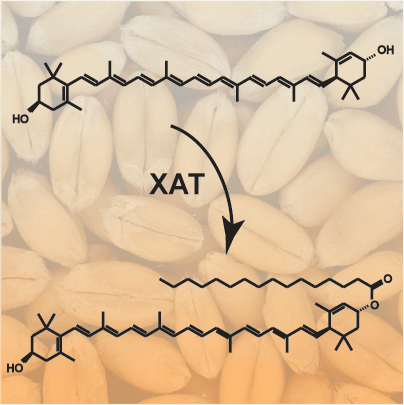当前位置:
X-MOL 学术
›
Plant Cell
›
论文详情
Our official English website, www.x-mol.net, welcomes your feedback! (Note: you will need to create a separate account there.)
A GDSL Esterase/Lipase Catalyzes the Esterification of Lutein in Bread Wheat.
The Plant Cell ( IF 11.6 ) Pub Date : 2019-10-01 , DOI: 10.1105/tpc.19.00272 Jacinta L Watkins 1 , Ming Li 2 , Ryan P McQuinn 1 , Kai Xun Chan 3, 4 , Heather E McFarlane 5 , Maria Ermakova 6 , Robert T Furbank 6 , Daryl Mares 2 , Chongmei Dong 7 , Kenneth J Chalmers 2 , Peter Sharp 7 , Diane E Mather 8 , Barry J Pogson 9
The Plant Cell ( IF 11.6 ) Pub Date : 2019-10-01 , DOI: 10.1105/tpc.19.00272 Jacinta L Watkins 1 , Ming Li 2 , Ryan P McQuinn 1 , Kai Xun Chan 3, 4 , Heather E McFarlane 5 , Maria Ermakova 6 , Robert T Furbank 6 , Daryl Mares 2 , Chongmei Dong 7 , Kenneth J Chalmers 2 , Peter Sharp 7 , Diane E Mather 8 , Barry J Pogson 9
Affiliation

|
Xanthophylls are a class of carotenoids that are important micronutrients for humans. They are often found esterified with fatty acids in fruits, vegetables, and certain grains, including bread wheat (Triticum aestivum). Esterification promotes the sequestration and accumulation of carotenoids, thereby enhancing stability, particularly in tissues such as in harvested wheat grain. Here, we report on a plant xanthophyll acyltransferase (XAT) that is both necessary and sufficient for xanthophyll esterification in bread wheat grain. XAT contains a canonical Gly-Asp-Ser-Leu (GDSL) motif and is encoded by a member of the GDSL esterase/lipase gene family. Genetic evidence from allelic variants of wheat and transgenic rice (Oryza sativa) calli demonstrated that XAT catalyzes the formation of xanthophyll esters. XAT has broad substrate specificity and can esterify lutein, β-cryptoxanthin, and zeaxanthin using multiple acyl donors, yet it has a preference for triacylglycerides, indicating that the enzyme acts via transesterification. A conserved amino acid, Ser-37, is required for activity. Despite xanthophylls being synthesized in plastids, XAT accumulated in the apoplast. Based on analysis of substrate preferences and xanthophyll ester formation in vitro and in vivo using xanthophyll-accumulating rice callus, we propose that disintegration of the cellular structure during wheat grain desiccation facilitates access to lutein-promoting transesterification.plantcell;31/12/3092/FX1F1fx1.
中文翻译:

GDSL 酯酶/脂肪酶催化面包小麦中叶黄素的酯化。
叶黄素是一类类胡萝卜素,是人类重要的微量营养素。它们经常被发现与水果、蔬菜和某些谷物(包括面包小麦(Triticum aestivum))中的脂肪酸酯化。酯化促进类胡萝卜素的封存和积累,从而增强稳定性,特别是在收获的小麦籽粒等组织中。在这里,我们报道了一种植物叶黄素酰基转移酶(XAT),它对于面包小麦籽粒中的叶黄素酯化是必要且充分的。XAT 包含典型的 Gly-Asp-Ser-Leu (GDSL) 基序,由 GDSL 酯酶/脂肪酶基因家族的成员编码。来自小麦和转基因水稻 (Oryza sativa) 愈伤组织等位基因变体的遗传证据表明,XAT 催化叶黄素酯的形成。XAT 具有广泛的底物特异性,可以使用多个酰基供体酯化叶黄素、β-隐黄质和玉米黄质,但它偏爱三酰基甘油酯,表明该酶通过酯交换作用发挥作用。活性需要保守氨基酸 Ser-37。尽管叶黄素是在质体中合成的,但 XAT 却在质外体中积累。基于使用积累叶黄素的水稻愈伤组织对底物偏好和体内外底物偏好和叶黄素酯形成的分析,我们提出小麦籽粒干燥过程中细胞结构的分解有利于叶黄素促进酯交换。plantcell;31/12/3092/ FX1F1fx1。
更新日期:2019-12-11
中文翻译:

GDSL 酯酶/脂肪酶催化面包小麦中叶黄素的酯化。
叶黄素是一类类胡萝卜素,是人类重要的微量营养素。它们经常被发现与水果、蔬菜和某些谷物(包括面包小麦(Triticum aestivum))中的脂肪酸酯化。酯化促进类胡萝卜素的封存和积累,从而增强稳定性,特别是在收获的小麦籽粒等组织中。在这里,我们报道了一种植物叶黄素酰基转移酶(XAT),它对于面包小麦籽粒中的叶黄素酯化是必要且充分的。XAT 包含典型的 Gly-Asp-Ser-Leu (GDSL) 基序,由 GDSL 酯酶/脂肪酶基因家族的成员编码。来自小麦和转基因水稻 (Oryza sativa) 愈伤组织等位基因变体的遗传证据表明,XAT 催化叶黄素酯的形成。XAT 具有广泛的底物特异性,可以使用多个酰基供体酯化叶黄素、β-隐黄质和玉米黄质,但它偏爱三酰基甘油酯,表明该酶通过酯交换作用发挥作用。活性需要保守氨基酸 Ser-37。尽管叶黄素是在质体中合成的,但 XAT 却在质外体中积累。基于使用积累叶黄素的水稻愈伤组织对底物偏好和体内外底物偏好和叶黄素酯形成的分析,我们提出小麦籽粒干燥过程中细胞结构的分解有利于叶黄素促进酯交换。plantcell;31/12/3092/ FX1F1fx1。


























 京公网安备 11010802027423号
京公网安备 11010802027423号